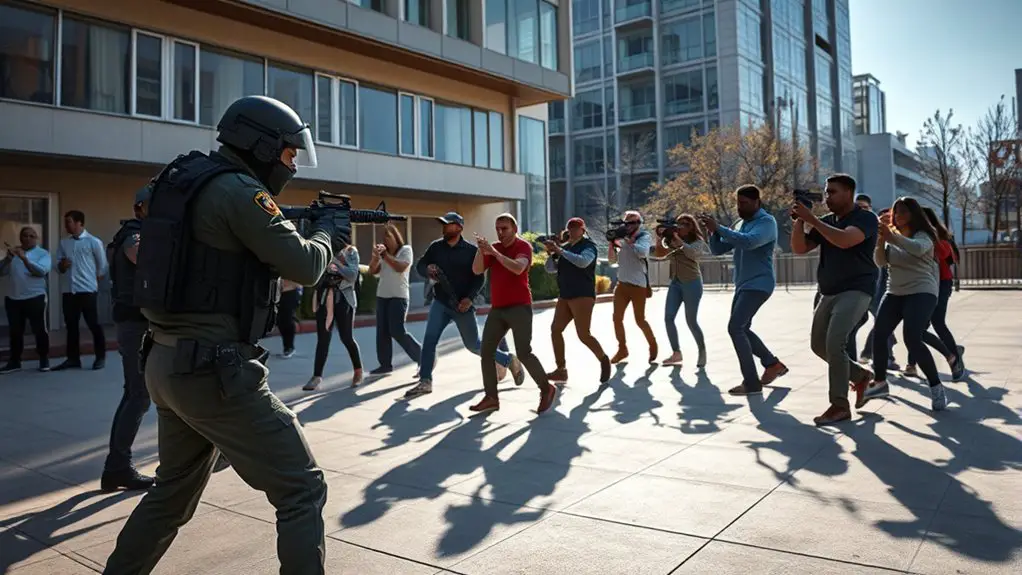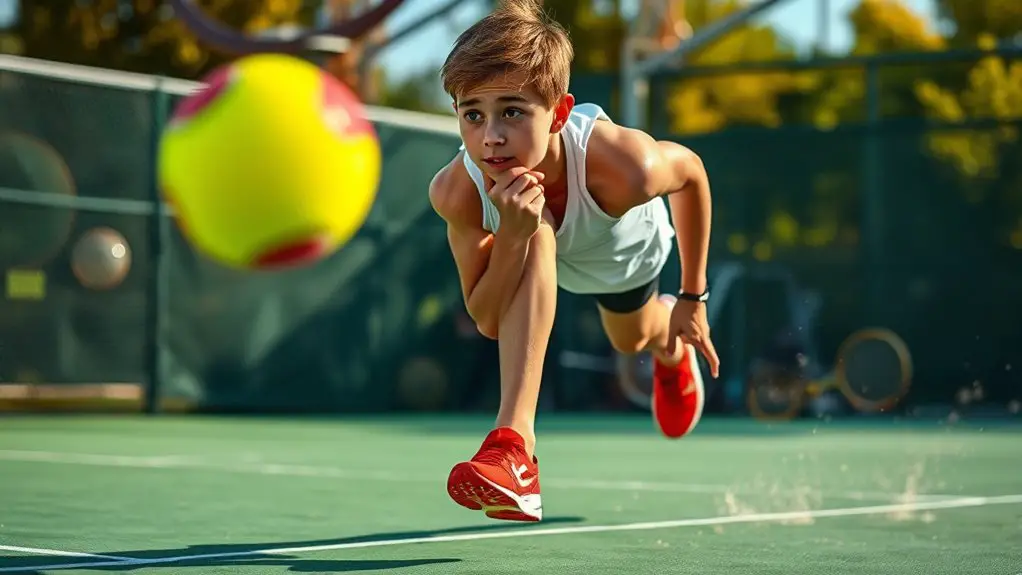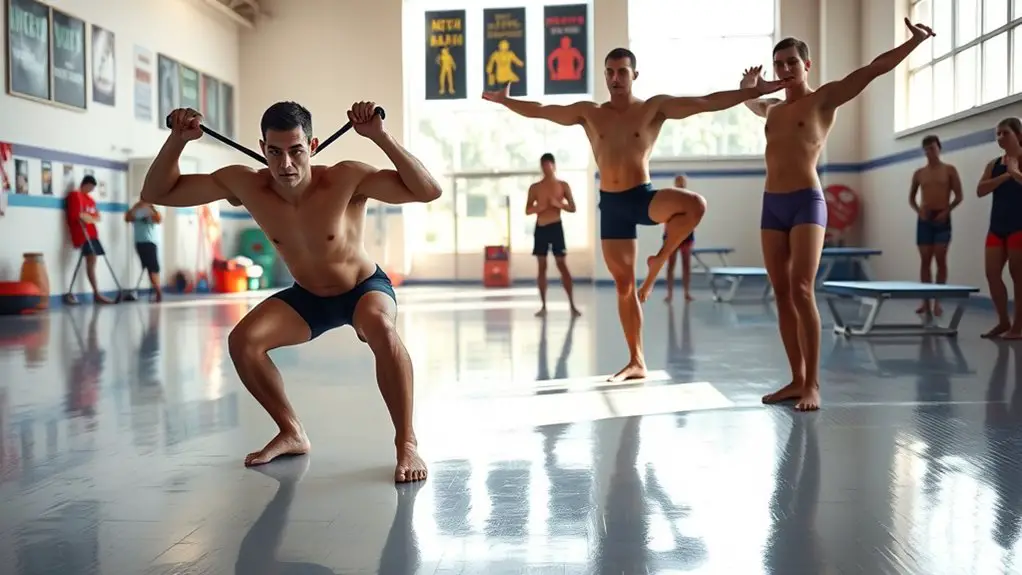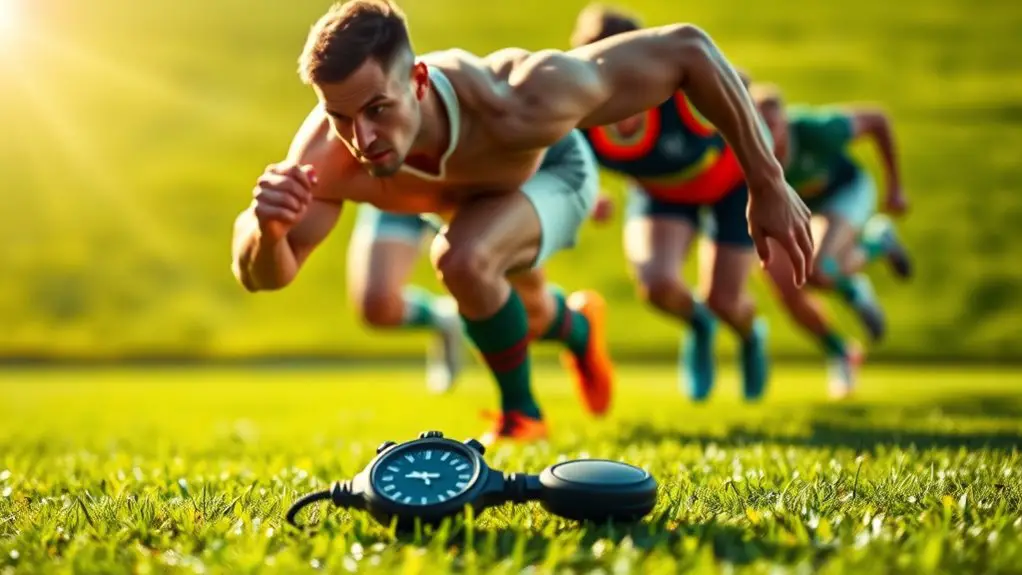To improve perimeter defense against shooters, you need to understand their shooting range and release. Master a balanced defensive stance and keep your footwork agile. Communicate effectively with teammates using verbal cues and nonverbal signals. Always anticipate offensive movements like cuts and weight shifts. When closing out on shooters, sprint towards them while keeping your focus on their waist and extend your arms to contest shots. There's much more to enhance your skills and strategies.
Understand the Shooter's Range and Release
To effectively defend against shooters, you need to understand their range and release mechanics. Knowing the shooter psychology behind shot selection can give you the edge. Every shooter has a comfort zone—recognizing where they feel most confident helps you anticipate their moves. You'll want to gauge their shooting range, as this determines how aggressively you should close out on them.
When a shooter is in their sweet spot, they're more likely to take the shot, so be aware of their body language and timing. If they've got a quick release, you need to be even more alert. Stay low, keep your hands up, and watch their eyes; they'll give away their intent. By reading these cues, you can disrupt their rhythm, making it harder for them to execute their shot selection. Mastering this knowledge is key to enhancing your perimeter defense.
Master Defensive Stance and Footwork
Understanding a shooter's range and release is only part of the equation; mastering your defensive stance and footwork is equally important in perimeter defense. Your ability to stay balanced and agile can make all the difference. Start by focusing on your defensive positioning—keep your knees bent and your body low. This stance not only helps you react quickly but also makes it harder for an opponent to drive past you.
Incorporate footwork drills into your practice routine. Simple exercises like lateral shuffles and quick pivots will enhance your agility and speed. Always be ready to adjust your position based on the shooter's movements. Remember, the key to effective perimeter defense lies in being proactive rather than reactive. The more comfortable you are with your footwork, the more control you'll have over your defensive game. Additionally, mastering proper foot placement can aid in maintaining balance and stability during your movements. Embrace these skills, and you'll find yourself becoming a formidable presence on the court.
Communicate Effectively With Teammates
While you might excel in your individual defensive skills, communicating effectively with your teammates can elevate your perimeter defense to a whole new level. Use verbal cues and nonverbal signals to stay in sync. A simple shout can alert a teammate about a screen, while a quick hand gesture can indicate a switch.
| Verbal Cues | Nonverbal Signals | Purpose |
|---|---|---|
| "Screen left!" | Pointing left | Alert for screens |
| "Help!" | Raising hand | Call for assistance |
| "Switch!" | Hand signal to switch | Change assignments |
Anticipate Offensive Movements and Cuts
Anticipating offensive movements and cuts is essential for effective perimeter defense, as it allows you to stay one step ahead of your opponent. By honing your skills in reading cues, you can decipher your rival's intentions and counter their offensive strategies. Watch for subtle body language, like a shifting weight or a quick glance toward the basket; these can signal where they plan to move next.
Stay light on your feet and ready to adjust your positioning based on their actions. Trust your instincts but also be aware of your surroundings. The more you practice deciphering these cues, the more natural it'll feel, giving you the freedom to react swiftly. Remember, the goal is to disrupt their rhythm and limit their scoring opportunities. With sharp anticipation, you'll not only improve your defense but also empower your team to take control of the game.
Practice Closeouts and Contesting Shots
To effectively defend against perimeter shooters, mastering the technique of closeouts is essential. You need to prioritize your defensive positioning to challenge their shot without fouling. Start by sprinting toward the shooter, keeping your eyes on their waist to maintain balance and control. As you close out, extend your arms to create a barrier, disrupting their rhythm and forcing them to reconsider their shot selection strategy.
Don't just run blindly; be aware of your surroundings and anticipate their next move. Adjust your speed and angle based on the shooter's tendencies. If they're a quick trigger, you may need to close out faster; if they like to pump fake, be ready to stay grounded. Incorporating dynamic stretching into your warm-up can enhance your agility, helping you react quicker on the court.
Practicing these closeout techniques consistently will enhance your ability to contest shots effectively, giving you the freedom to challenge shooters confidently and improve your team's overall perimeter defense.
Frequently Asked Questions
How Can I Assess a Shooter's Shooting Form?
To assess a shooter's shooting form, you'll want to focus on their shooting technique. Start by observing their stance, grip, and follow-through. Use a form analysis method, like video recording, to capture key moments for later review. Look for consistency in their mechanics and identify any flaws. By breaking down each aspect, you can pinpoint areas for improvement, ultimately helping the shooter enhance their performance and gain confidence on the court.
What Are Common Mistakes in Perimeter Defense?
You know what they say, "a chain is only as strong as its weakest link." In perimeter defense, common mistakes include poor guard positioning and failing to communicate effectively with teammates. If you're not aware of your surroundings or your teammate's movements, it leads to a communication breakdown that can leave shooters open. Stay alert, keep your stance solid, and always talk to your teammates to guarantee you're all on the same page.
How Do I Mentally Prepare for Tough Shooters?
To mentally prepare for tough shooters, you've gotta focus on your mindset. Use mental imagery to visualize yourself successfully defending against them—picture their moves and how you'll react. Incorporate focus techniques like deep breathing to stay calm and centered. Embrace the challenge; it's an opportunity to elevate your game. Remember, confidence is key, and with the right mental tools, you can turn pressure into freedom on the court.
Can Diet and Fitness Affect Defensive Performance?
You're only as strong as your foundation. Diet and fitness play an essential role in defensive performance. Proper nutrition impacts your energy levels and recovery, allowing you to stay sharp during games. Fitness routines enhance your agility and endurance, helping you keep up with fast-paced plays. By focusing on what fuels your body, you'll find your performance improves, giving you the freedom to defend effectively against any opponent.
What Drills Improve Lateral Quickness for Defense?
To boost your lateral quickness for defense, you should focus on drills that enhance your lateral agility. Try incorporating defensive slides into your routine. Start with a stance, then slide side to side, keeping your hips low and feet quick. You can also do cone drills, weaving in and out to sharpen your movement. These exercises will help you stay nimble, giving you the freedom to react faster during games and improve overall defensive performance.




